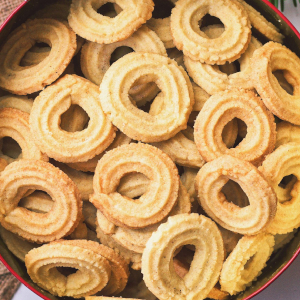Time to look at the aspect of Danish cuisine that many of us were most familiar with before we embarked on this week’s tour: desserts and quaffs. And I’m sure your sweet tooth is just aching to learn more about the most famous Danish sweet: The Danish Pastry. But prepare to be shocked!
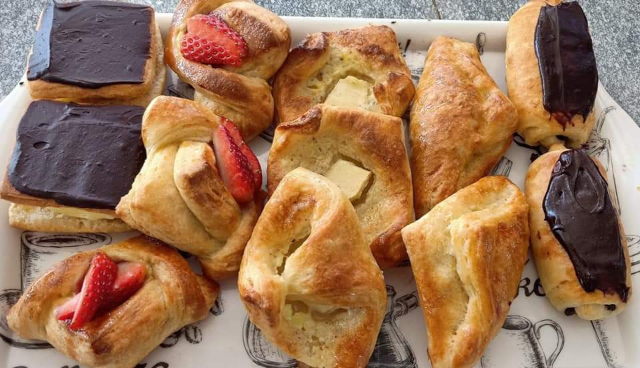 A selection of what most non-Danes would consider ‘unconventional’ Danish Pastries…
A selection of what most non-Danes would consider ‘unconventional’ Danish Pastries…
The Danish Pastry (usually shortened, through familiarity, in the rest of the world, to just ‘Danish’) is not a Danish invention. Per se. In fact, the crispy, layered twisted pastry, with a centre eye perfect for filling, was introduced by Austrian bakers invited to fill in for striking local bakers in 1850. They brought a number of innovations, one of which was classic puff pastry, the butter-layered treat upon which criossantes and other classic desserts are based. As usual, the Danes modified puff to their own taste, adding more eggs and butter. Today, you can get just about any kind of Danish Pastry you want. But first, you should be aware there are quite a few different Danish forms and variants to take into account.
My personal education in danish Baked goods came courtesy of The Danish Pastry House in Mississauga, a city just west of Toronto where my mother and step dad lived before he died. The fact is, you can find authentic food from just about every culture there, because the place has been a magnet for immigrants with the culinary touch. The Danish Pastry House lists no fewer than 18 different pastries on its permanent menu, and there’s a separate list for cakes, tarts and cookies. Not to mention the other list of daily breads.
What follows is a very selective list of different pastries, cakes and other Danish deserts you really must try before you die….
On our menu today
Wienerbrød: ‘Vienna Bread’; what The Danish call ‘Danish Pastries’. In fact, they call Danishes by a version of that name throughout the Germanic and Scandinavian countries. But in Austria, they call them ‘Dänischer Plunder’ – sort of backhandedly crediting the Danes with their invention. Or maybe the Austrians just don’t want people to get the Danish versions confused with their original classics!
Småkager: Danish Butter Cookies. A whole family of crispy, buttery cookies incorporating a variety of traditional toppings including marzipan, chocolate, chopped nuts and dried fruits.
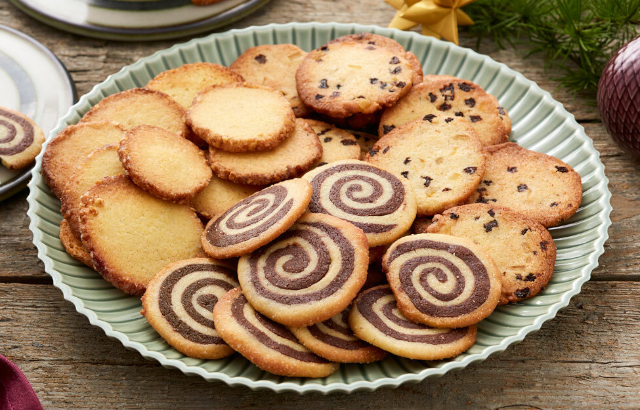
You can get genuine made-in-Denmark Butter Cookies every yuletide in the seasonal specialty aisle of most supermarkets and many bakeries. Look for the decorative blue tins with the ornate, old-world decorations.
Vaniljekranse: Vanilla-Almond Cookies (see photo, top of page). Distinguished from regular Butter Cookies by the addition of extra butter, a distinct vanilla flavour and a hint of Almond. They’re also made in a special shape; dough piped out in a circle leaving a hole in the middle. You’ll probably get a precious few of these in your imported Småkager selection!
Lagkage: A family of 3-layer sponge cakes filled with fruit and various pastry creams and frostings, and always topped with lots of whipped cream.

A Lagkage is a must at birthdays and always expected on most other festive occasions.
Æblekage: ‘Apple Cake’, but really a layered dessert alternating layers of cinnamon-spiced apple sauce and crumbled cookies. It’s sort of a rustic trifle, but amazingly easy to make! Always topped with a fruit preserve of your choice.
Koldskål: A cold soup, sometimes served as a drink. A base of buttermilk is flavoured and thickened with yogurt, sugar, lemon juice, vanilla and eggs.
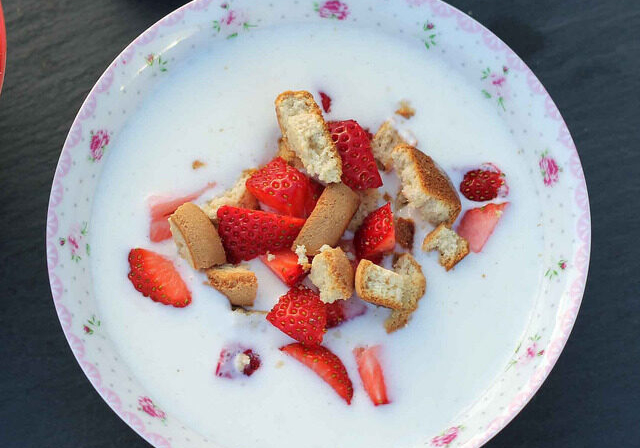
It’s traditionally served as a refreshing cold summer treat.
Risengrød: A special thick, sweet rice pudding most folks make only at Christmas. It has ancient roots and is considered a culinary icon of the season. As with most other Rice Puddings, short-grained rice is cooked and cooked (simmered) in milk until it breaks down almost completely into a smooth pudding that might remind you, just to look at it, of Cream of Wheat. Vanilla may be added along with a good pinch of salt. To serve, ladle a fair amount into a big bowl and garnish with Cinnamon Sugar and a knob of butter. Sounds simple – and it is. What it requires most is patience!
Beverages
Akvavit: Where Americans are known for ordering a shot of Bourbon, Canadians will order a shot of Rye, and Brits are likely to order Scotch. But Danes will order Akvavit.
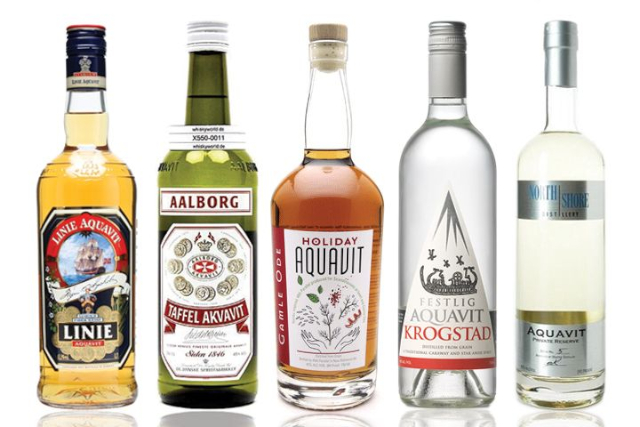
This spirit is based on grain or potato distillate, and flavoured with caraway. The name comes from the Latin aqua vitae, which means ‘water of life’. This is the toasting beverage of all Danish special occasions.
Brennivin: Danish Schnapps. An equivalent to Vodka that far pre-dates the first appearance of Vodka in Scandinavia and Eastern Europe. Brennivin is also compared to Gin, but it’s augmented with spices such as caraway and dill, rather than Juniper Berries. Like Akvavit, it’s based on alcohol distilled from grains or potatoes.
Dansk Mjød: Danish Mead. Honey wine with augmentations, each as unique as the geographic locale whence it comes. The first known reference to Mead comes from the Hindu Holy Books (the Vedda) which date back 4,000 years.
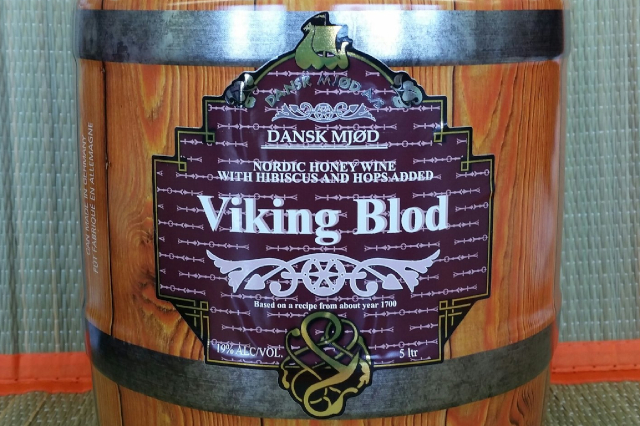
‘Modern’ references are found in the classic Viking Myths and Legends. Danish Mead is traditionally made of water, honey and yeast. The most famous brand, Viking Blod, is augmented with hibiscus and hops, which impart what the maker calls, “a soft, citrus-like flavor and very floral aroma. Its finish is hoppy-dry, spicy, and very warming.”
Beer: The most common Danish brew is Pilsner, and Carlsberg is probably the best-known brand, sold around the world. But the Carlsberg Brewery makes more than 150 different beers in 144 different markets.
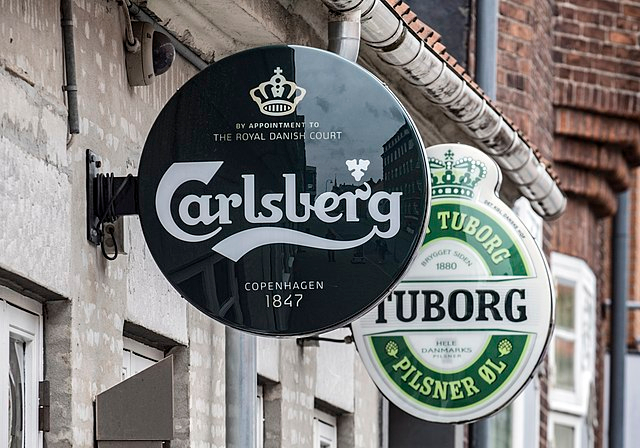
Tuborg is another Danish beer known world-wide. Across Denmark, folks wait impatiently for the limited release of Tuborg Christmas Ale, another icon of the season.
Glogg: Mulled Wine enjoyed in various national forms across Scandinavia. In Denmark, it’s most often made of wine spiced with nutmeg, cloves, and cinnamon. Here, along with Koldskål, is another ancient Danish winter tradition!
Fruit Wines & Spirits: Denmark is too far north; too cold for grapes to thrive. But the Danes do make wine and spirits – from fruits. Elderberries and cherries are particularly popular.
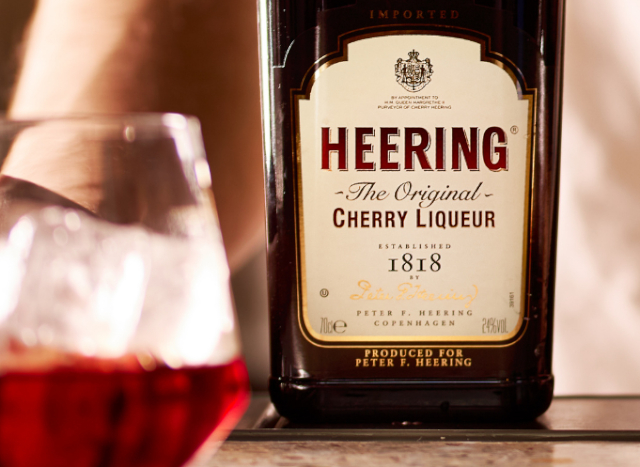
A leading Danish liqueur export is Cherry Heering, described glowingly in the Liquor Control Board of Ontario online catalogue: “Cherry Heering, purveyor to H.M. Queen Elizabeth II and to the Royal Danish Court, has been produced since 1818 and is the original cherry brandy. Intensely aromatic notes of preserved cherries, with almond and herbal notes; sweet, with a viscous texture and intense cherry flavours; the finish is long, warm and sweet.” What more could one say?
I hope you’ve had your fill of Denmark!
Your typical Danish host wouldn’t let you leave without your assurance that you’d been properly fed and toasted! I also hope this internet-asisterd survey of Danish food and culinary customs has filled you with the kind of joy the Danes typically feel when they celebrate any special occasion – which always hinges on rich and plentiful food and drink!
~ Maggie J.

